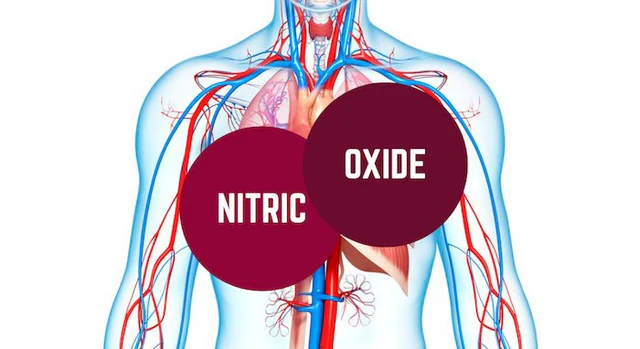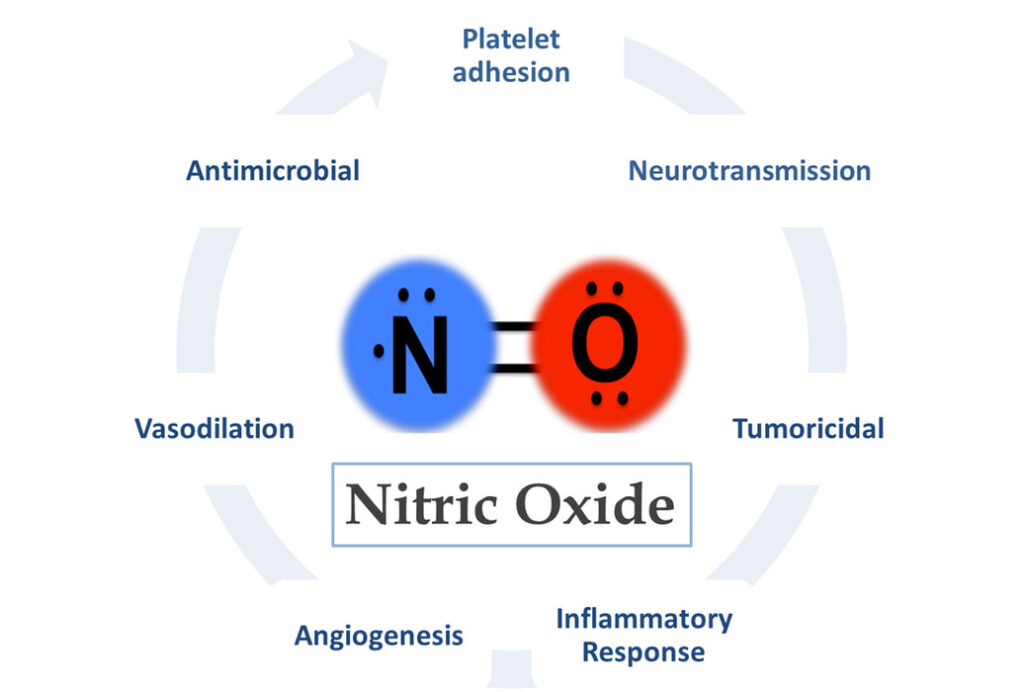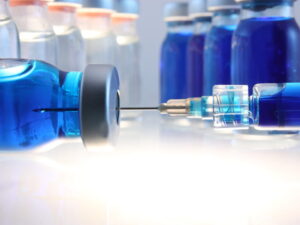Book Appointment Now

Nitric Oxide in the Body
- On
- InUncategorized

NITRIC OXIDE IN THE BODY
Since the discovery of nitric oxide as a signaling molecule in the cardiovascular system by Nobel Prize Winner Dr. Louis Ignarro and two other scientists in 1998, nitric oxide has seen a considerable amount of research. There is so much research because nitric oxide impacts nearly every system of the body. It is a neurotransmitter – a communicator targeting cells in muscles, organs, and other parts of the body. It is a vital part of life and overall health. Nitric oxide is produced endogenously, meaning it originates from within our body. Its production decreases as we age. We are continuously learning more about this complex gas and how nitric oxide, presence or absence impacts health, healing, and disease.
HOW NITRIC OXIDE WORKS IN THE BODY
Nitric oxide in the body is produced in several ways that can co-occur. It’s a vital gas that relaxes smooth muscles and impacts tissue oxygenation and nutrient flow in the circulatory system. Nitric oxide is produced enzymatically by way of the amino acid conversion from L-arginine to L-citrulline and nonenzymatically in the stomach and surface of the skin, as examples. In the vasculature alone, the list of nitric oxide pathways gives a clue about the many ways nitric oxide is produced.
There are three isoforms of NOS (Nitric Oxide Synthase: a family of enzymes catalyzing L-arginine to nitric oxide) that have been identified thus far. We know them as:
- Neuronal NOS (NOS1 or nNOS) – the enzyme responsible for the synthesis of nitric oxide by neurons.
- Inducible NOS (NOS2 or iNOS) – induced by cytokines and lipopolysaccharide (LPS). Inducible NOS produces large amounts of nitric oxide for extended periods of time.
- Endothelial NOS (NOS3 or eNOS)
The many production locations and methods of nitric oxide in the body:
- Hydroxylation of l-arginine by NOS1 located in nerve fibers; mast cells
- Hydroxylation of l-arginine by NOS2 located in macrophages; aged endothelium; many tissues under inflammatory conditions
- Hydroxylation of l-arginine by NOS3 located in vascular endothelium; erythrocytes
- Nitrite reduction by NOS3 in the endothelium
- mtNOS in the parenchymal tissues
- S-nitrosohemoglobin located in the erythrocytes
- S-nitroso-glutathione or S-nitrosoalbumin located in plasma
- Nitrite reduction by hemoglobin located in erythrocytes, plasma
- Nitrite reduction by myoglobin located in skeletal muscle and myocardial tissue
- Nitrite reduction by xanthine oxidoreductase located in ischemic tissues
- Nitrate and nitrite reductions by cytochrome located in various tissue
These complex methods for nitric oxide production are supported by a simple high nitrate-rich diet from sources such as red spinach, beets, and dark leafy greens. The more nitrate consumed the more conversion to nitrite and the more production of nitric oxide in the body.
NITRIC OXIDE PRODUCTION DROPS WITH AGE
Nitric oxide in the body modulates many processes involved in aging, which is why researchers believe that aging stands alone as an independent factor that impairs nitric oxide production.
One study published in The Journal of American Heart Association that specifically looked at the occurrence of diminished nitric oxide production with aging discovered some interesting findings:
Platelets are tiny cells in your blood that form clots and stop bleeding. For millions of Americans, they are essential to surviving and fighting cancer, chronic diseases, and traumatic injuries. Every 15 seconds someone needs platelets. Platelets must be used within five days and new donors are needed every day.
- Aging is associated with reductions in platelet nitric oxide responsiveness – nitric oxide is vital for proper functioning platelets which, for example, help the blood coagulate when open wound injuries occur.
- Females tend to have a pronounced reduction in nitric oxide production and greater arterial stiffness with time
Another study published in the medical journal which examined the impact of aging on nitric oxide production found a 75% loss in endothelium-derived nitric oxide in 70-80-year-old patients when compared to healthy 20-year-olds. This study helped researchers extrapolate the rate aCirculationt which nitric oxide production declines, which is roughly 10% every decade that we are alive.
NITRIC OXIDE REDUCES WORKOUT INFLAMMATION
Exercise-induced oxidative stress creates an inflammatory response in the body. Dietary nitrate has been shown to help reduce oxidative stress in joints and muscles. One study published in Nutrition Reviews showed that a diet rich in nitrate and nitrite favorably supported cell function reduced the proinflammatory process, and improved vascular and immune cell function.
Nitric oxide is produced by L-citrulline malate. In a study by the Journal of Nutritional Science Vitaminol, an uptake of L-citrulline in the body was shown to increase nutrient delivery and clear waste products from fatigued muscle, like ammonia and lactate.
Studies support an increase in dietary sources of nitric oxide production, including a diet rich in nitrate, nitrite, L-citrulline, and L-arginine to help mitigate the effects of exercise-induced inflammation.
NITRIC OXIDE AND BOOSTING IMMUNITY
Nitric oxide plays a few direct roles in activating the immune system when a threat like a virus or bacteria is detected. Some of the key immune functions supported by nitric oxide in the body include:
- Transportation of immune cells
- Immune cell oxygen
- Increased blood flow
- Vitamin C and nitric oxide production
WHEN THE BODY IS DEFICIENT IN NITRIC OXIDE
There are some telltale signs of low nitric oxide production that are important to watch for. These are 6 common nitric oxide deficiency symptoms that you should be looking out for:
- Changes in vision
- Increase in body heat
- Decrease in movement and flexibility
- Chronic stress
- Low energy
- Slow recovery times
Nitric oxide in the body is difficult to measure as it is a rapidly expended gas with a half-life of just 1-3 minutes. Still, there are ways to determine general healthy nitric oxide production levels.
Newsletter Updates
Enter your email address below and subscribe to our newsletter




